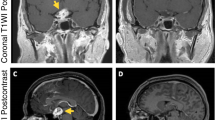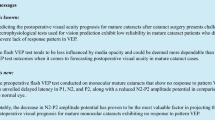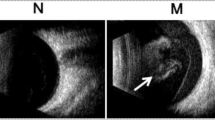Abstract
This prospective clinical study was undertaken to assess the value of flash visually evoked potential (FVEP) in predicting postoperative visual acuity levels in severely injured eyes with opaque media. We found that FVEP testing at 10 Hz stimuli is of sufficient predictive value for postoperative visual outcome in most cases with severe eye trauma.
Similar content being viewed by others
References
Hutton WL, Fuller DG. Factors influencing final visual results in severely injured eyes. Am J Ophthalmol. 1984;97:715–722.
Fuller DG, Hutton WL. Prediction of postoperative vision in eyes with severe trauma. Retina. 1990;10:24–34.
Greenberg RS. Medical Epidemiology. East Norwlk, Conn.: Appleton and Lange; 1993;60.
Kuhn F, Morris R, Witherspoon D, Heimann K, Jeffers JB, Treister G. A standardized classification of ocular trauma. Ophthalmology. 1996;103:240–243.
De Juan E, Strenberg P, Michels RG. Penetrating ocular injuries. Ophthalmology. 1983;90:1318–1322.
Williams DF, Mieler WF, Abrams GW, Lewis H., Results and prognostic factors in penetrating ocular injuries with retained intraocular foreign bodies. Ophthalmology. 1988;95:911–916.
Pieramici DJ, MacCumber MW, Humayun MU, Marsh MJ, De Juan E. Open globe injury: update on types of injuries and visual results. Ophthalmology. 1996;103:1798–1803.
Crews SJ, Thompson CRS, Harding GFA. The ERG and VEP in patients with severe eye injury. Doc Ophthalmol Proc Ser. 1978;15:203–209.
Contestabile MT, Suppressa F, Vincenti P, D'Alba E, Gullace R. Flash visual-evoked potentials and flash electroretinography in the preoperative visual prognosis of eyes with cataracts. Ann Ophthalmol. 1991;23:416–421.
Tsinapoulos T, Karyophyllis K, Konstas P. Electroretinography in the detection of functional conduction of the retina in cataract. Arch Ophthalmol Soc Northern Greece. 1972;18:69–74.
Weinstein GW. Clinical aspects of the visually evoked potentials. Trans Am Ophthalmol Soc. 1977;75:627–673.
Perry NW, Chielders DG. The Human Visual Evoked Response. Springfield, Ill.: Charles C. Thomas; 1969;12–48.
Ilker SS, Sobaci G, Yildirim E. The normal values of ERG, EOG, flash VER and pattern VER in our populations. Turk Oftalmol Gaz. 1992;22:193–195.
Author information
Authors and Affiliations
Additional information
Dr. Tatar is in private practice.
Rights and permissions
About this article
Cite this article
Sobaci, G., Mutlu, F.M., Söyler, M. et al. Using flash visually evoked potential in predicting final visual acuity in severely injured eyes. Ann Ophthalmol 32, 63–65 (2000). https://doi.org/10.1007/s12009-000-0015-4
Issue Date:
DOI: https://doi.org/10.1007/s12009-000-0015-4




